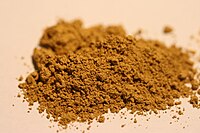
In situ X-ray fluorescence-based method to differentiate among red ochre pigments and yellow ochre pigments thermally transformed to red pigments of wall paintings from Pompeii
Sign Up to like & getrecommendations! Published in 2017 at "Analytical and Bioanalytical Chemistry"
DOI: 10.1007/s00216-017-0329-3
Abstract: Most of the magnificent wall paintings from the ancient city of Pompeii are decorated with red and yellow colors coming from the ochre pigments used. The thermal impact of the pyroclastic flow from the eruption… read more here.
Keywords: yellow ochre; wall paintings; red ochre; ochre ... See more keywords

Investigation of gilding materials and techniques in wall paintings of Kizil Grottoes
Sign Up to like & getrecommendations! Published in 2020 at "Microchemical Journal"
DOI: 10.1016/j.microc.2019.104548
Abstract: Abstract The present work reports the new characterization results of the gilding materials used in Cave 171 of Kizil Grottoes, China, which is dated between 5th and 7th Century, A.D. Tiny samples collected from four… read more here.
Keywords: wall paintings; gilding materials; paintings kizil; materials techniques ... See more keywords

Challenges of Conserving Wall Paintings: A 30-Year Perspective
Sign Up to like & getrecommendations! Published in 2020 at "Studies in Conservation"
DOI: 10.1080/00393630.2020.1770418
Abstract: ABSTRACT Wall paintings are physically indivisible from the built heritage, which makes their conservation difficult. Conservation measures focus on stabilising paintings and slowing deterioration, while preserving significance and authenticity. Achieving these aims is complicated. The… read more here.
Keywords: wall paintings; challenges conserving; conservation; wall ... See more keywords

Evaluation of polyvinyl alcohol–borax/agarose (PVA–B/AG) blend hydrogels for removal of deteriorated consolidants from ancient Egyptian wall paintings
Sign Up to like & getrecommendations! Published in 2019 at "Heritage Science"
DOI: 10.1186/s40494-019-0264-z
Abstract: This study concerns the assessment of a new polyvinyl alcohol–borax/agarose blend hydrogel (PVA–B/AG) tailored for the conservation of ancient Egyptian wall paintings. The increasing problems of deteriorated consolidants affecting ancient wall paintings have attracted the… read more here.
Keywords: wall paintings; ancient egyptian; pva blend; wall ... See more keywords

Preventing the Undesired Surface Veiling after Nanolime Treatments on Wall Paintings: Preliminary Investigations
Sign Up to like & getrecommendations! Published in 2021 at "Coatings"
DOI: 10.3390/coatings11091083
Abstract: During the last decades, the discovery of nanolime and its introduction in the field of Cultural Heritage has entailed a significant advance for the consolidation of historic wall paintings. Nevertheless, its use is not completely… read more here.
Keywords: wall paintings; consolidation; treatment; preventing undesired ... See more keywords

Non-Invasive Characterisation of the Wall Paintings in the Byzantine Church of Palazzo Simi (Bari, Italy) and Digital Photogrammetric Survey for a Pigment Mapping
Sign Up to like & getrecommendations! Published in 2023 at "Coatings"
DOI: 10.3390/coatings13060996
Abstract: The paper illustrates the results of a non-invasive characterisation of pigments and their mixtures in the pictorial surfaces of the wall paintings (10th century) found in the Byzantine church of Palazzo Simi in Bari (Italy).… read more here.
Keywords: invasive characterisation; non invasive; wall paintings; spectroscopy ... See more keywords

A Multianalytical Investigation to Preserve Wall Paintings: A Case Study in a Hypogeum Environment
Sign Up to like & getrecommendations! Published in 2023 at "Materials"
DOI: 10.3390/ma16041380
Abstract: In the present study, a diagnostic approach was used to analyze the wall painting in the apse of the Sotterra church at Paola, in the province of Cosenza, Italy. The Sotterra church is nowadays located… read more here.
Keywords: wall; wall paintings; preserve wall; multianalytical investigation ... See more keywords

Sulfur Isotope Analysis to Examine the Provenance of Cinnabar Used in Wall Paintings in the Roman domus Avinyó (Barcelona)
Sign Up to like & getrecommendations! Published in 2020 at "Minerals"
DOI: 10.3390/min11010006
Abstract: Wall paintings in the Roman period were used to decorate both public and private spaces; therefore, they reflect, on the one hand, ideas and convictions, and on the other, daily activities and socio-economic models. Characterizations… read more here.
Keywords: wall paintings; isotope analysis; cinnabar; paintings roman ... See more keywords

Characterization of Wall Paintings of the Harem Court in the Alhambra Monumental Ensemble: Advantages and Limitations of In Situ Analysis
Sign Up to like & getrecommendations! Published in 2022 at "Molecules"
DOI: 10.3390/molecules27051490
Abstract: Non-invasive techniques (X-ray fluorescence, XRF, and Raman spectroscopy) were used for the study of the Hispano Muslim wall paintings. Principal component analysis (PCA) was performed on the semi-quantitative XRF results directly provided by the in-built… read more here.
Keywords: harem court; wall; wall paintings; analysis ... See more keywords